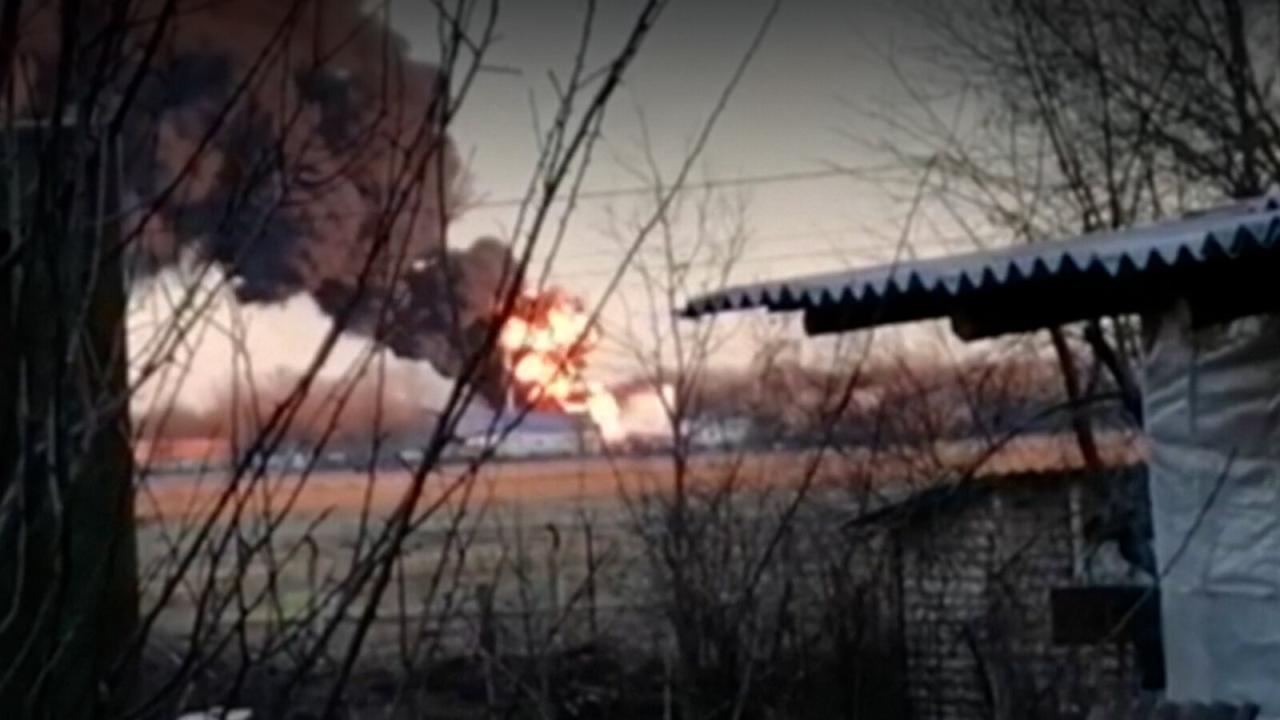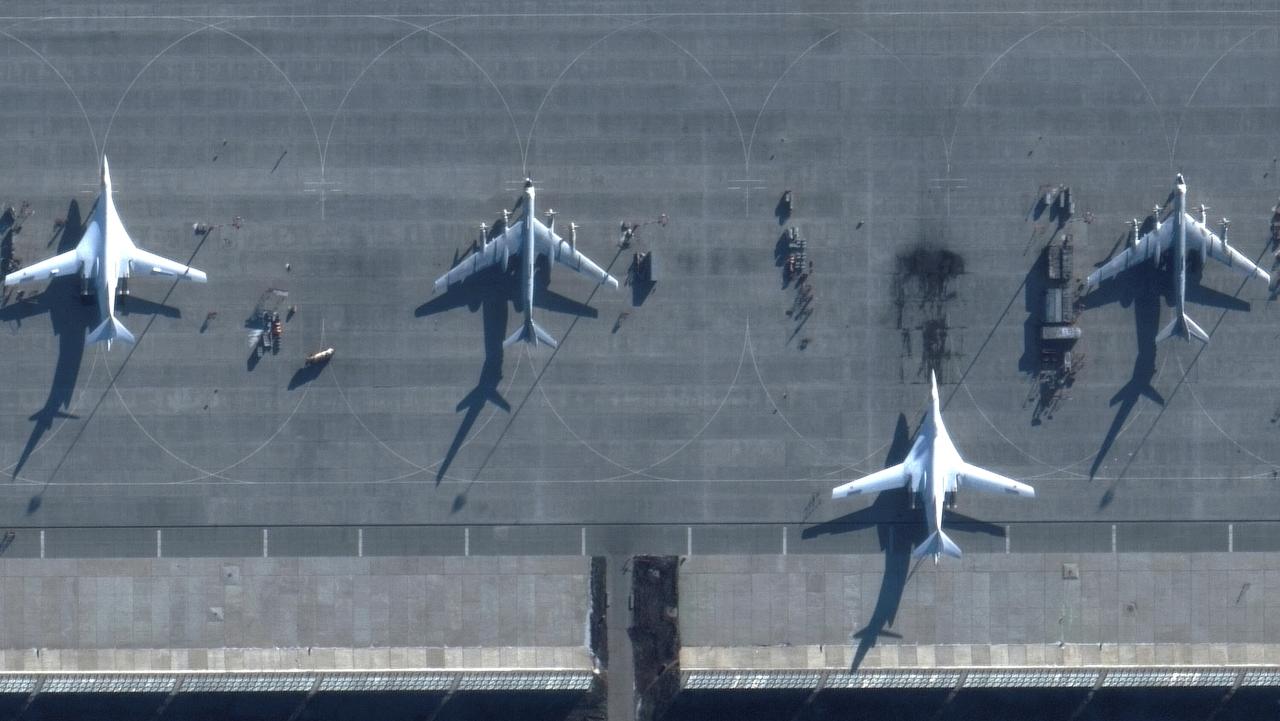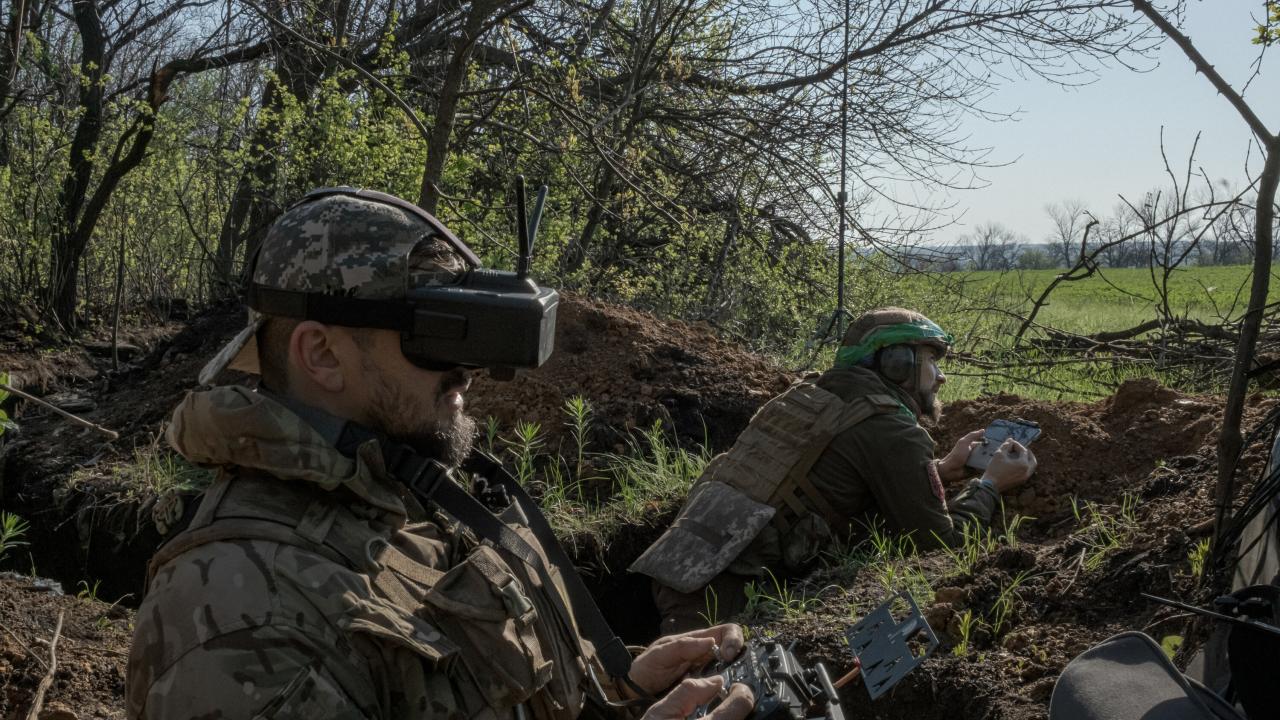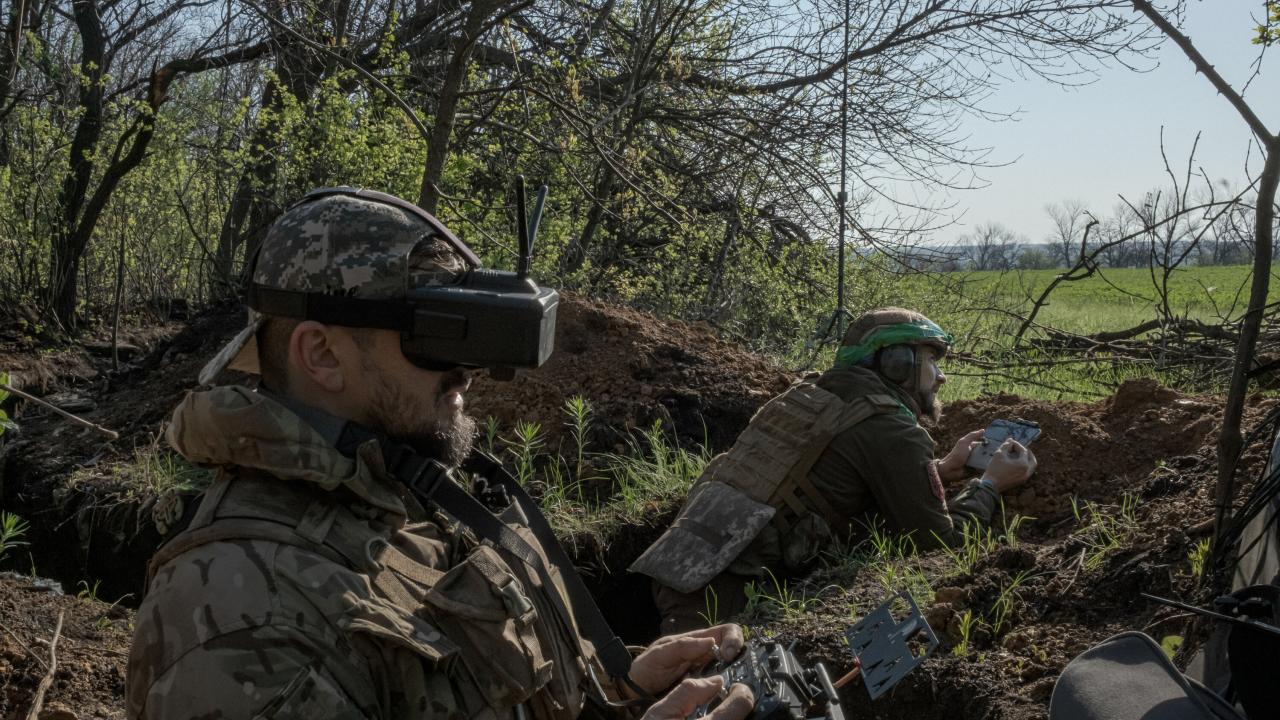Ukraine drone attack on russia – Ukraine drone attacks on Russia have become a significant aspect of the ongoing conflict, raising questions about military strategy, technological capabilities, and the evolving nature of warfare. These attacks, targeting various locations within Russia, represent a complex interplay of military objectives, logistical challenges, and international implications. Understanding the types of drones employed, the effectiveness of Russian countermeasures, and the broader geopolitical context is crucial to comprehending the evolving dynamics of this conflict.
This analysis will delve into the geographic scope of these attacks, examining the strategic significance of targeted regions and the logistical hurdles involved in their execution. We will also explore the diverse range of drones utilized, their technological capabilities, and their relative effectiveness. Furthermore, we will assess the military and civilian impact of these attacks, the Russian response, and the international community’s reaction, considering the narratives and propaganda surrounding the events.
Geographic Scope of Ukrainian Drone Attacks on Russia
Ukrainian drone attacks on Russian territory have targeted a range of locations, exhibiting a pattern influenced by both strategic importance and logistical feasibility. The frequency and intensity of attacks vary across regions, reflecting the evolving dynamics of the conflict.
Target Regions and Strategic Significance, Ukraine drone attack on russia
Several regions within Russia have experienced a disproportionate number of drone attacks. These include border regions like Belgorod and Bryansk, as well as regions further inland with strategic military installations or infrastructure. The targeting of border regions likely aims to disrupt logistics and exert pressure on Russian border defenses, while strikes on more distant locations suggest an attempt to reach high-value targets, demonstrating the reach of Ukrainian drone capabilities.
The strategic significance of each target location is directly related to its military or economic importance to Russia’s war effort.
Logistical Challenges of Drone Attacks

Launching drone attacks from Ukraine into various points within Russia presents significant logistical hurdles. Factors such as distance, terrain, and Russian air defenses influence the success rate and operational range of the drones. The need for extended flight times requires drones with substantial endurance, sophisticated navigation systems, and potentially mid-flight refueling capabilities (although evidence of this is currently lacking).
The further the target, the greater the risk of interception or malfunction.
Examples of Drone Attack Targets
| Target Location | Date of Attack (Approximate) | Type of Drone (if known) | Apparent Damage |
|---|---|---|---|
| Belgorod Oblast | Multiple dates throughout 2023 | Various UAVs (unspecified) | Varying degrees of damage to infrastructure and reported minor casualties |
| Bryansk Oblast | Multiple dates throughout 2023 | Various UAVs (unspecified) | Reported damage to oil refineries and other industrial facilities. |
| Moscow | May 2023, August 2023 | Likely modified commercial drones | Minimal physical damage, primarily symbolic impact. |
| Pskov Oblast | August 2023 | Reportedly several drones | Damage to several military transport aircraft. |
Types of Drones Used in Attacks
The drone attacks on Russia utilize a variety of unmanned aerial vehicles (UAVs), ranging from commercially available models modified for military purposes to potentially more sophisticated, purpose-built systems. The specific types employed are often not publicly disclosed, but analysis of available information suggests a diverse arsenal.
Drone Capabilities and Limitations
Commercially available drones, modified for longer range and payload capacity, are likely employed for shorter-range attacks, offering advantages in cost-effectiveness and ease of acquisition. However, their limitations include vulnerability to electronic countermeasures and shorter flight times compared to purpose-built military drones. More advanced drones, if used, would offer superior range, payload, and survivability but may be more difficult to acquire and operate.
Effectiveness of Drone Designs
The effectiveness of the various drone designs varies based on the target, the sophistication of the drone, and the effectiveness of Russian countermeasures. While some attacks have resulted in significant damage to military assets, others have caused minimal physical damage but significant psychological impact. The choice of drone type is likely influenced by the specific mission objectives and the risks involved.
Known and Suspected Drone Manufacturers and Models
- Various commercially available quadcopter models (modified)
- Potentially, domestically produced Ukrainian drones (details classified)
- Possibility of third-party supplied drones (unconfirmed)
Military and Civilian Impact of Drone Attacks
The impact of Ukrainian drone attacks on Russia extends beyond military targets, affecting civilian infrastructure and morale. Assessing the full extent of the impact requires careful consideration of both military and civilian consequences.
Damage to Military Installations
Reports indicate damage to various Russian military installations, including air bases, fuel depots, and ammunition storage facilities. The extent of the damage in each instance varies, with some attacks resulting in significant destruction of equipment and resources, while others cause more limited damage.
Civilian Casualties and Infrastructure Damage

While the primary focus of the attacks is military targets, there have been reports of civilian casualties and damage to civilian infrastructure in some instances. The exact numbers remain difficult to verify independently due to the nature of the conflict and the conflicting information from both sides. Determining the precise number of casualties and the extent of the damage to civilian infrastructure remains challenging due to the information control by both sides.
Impact on Russian Military Operations and Morale
The drone attacks have demonstrably impacted Russian military operations, disrupting logistics, and potentially reducing the effectiveness of certain units. The psychological impact on Russian military personnel and the population near the border regions is likely significant, contributing to a sense of insecurity and vulnerability. The repeated nature of these attacks serves as a constant reminder of Ukraine’s capacity to strike deep within Russian territory.
Comparative Analysis: Military vs. Civilian Impact
While the primary aim is to target military assets, the collateral damage to civilian infrastructure and the potential for civilian casualties remain a concern. A precise comparison of the impact on military versus civilian targets requires access to comprehensive and verifiable data, which is currently unavailable due to the complexities of the conflict and the competing narratives.
Russian Response and Defense Mechanisms
Russia has implemented a range of measures to counter the Ukrainian drone attacks, encompassing both technological advancements and strategic adjustments. The effectiveness of these countermeasures varies depending on the type of drone and the sophistication of the attack.
Recent Ukrainian drone attacks on Russian territory have highlighted the increasing sophistication of unmanned aerial vehicles in modern warfare. The capabilities showcased raise questions about the technological advancements in drone design, such as those offered by companies like sky elements drones , which are pushing the boundaries of what’s possible. These advancements, in turn, influence the strategic considerations surrounding future conflicts and the ongoing development of drone countermeasures.
Countermeasures Employed by Russia

Russia has deployed various counter-drone technologies, including electronic warfare systems designed to jam or disrupt drone signals, as well as missile defense systems capable of intercepting incoming drones. Additionally, they have increased air patrols and strengthened border security to detect and intercept drones before they reach their targets. Improved intelligence gathering and surveillance are also likely being employed to anticipate and prevent attacks.
Effectiveness of Russian Countermeasures
The effectiveness of Russian countermeasures is a subject of ongoing assessment. While some attacks have been successfully intercepted, others have reached their targets, suggesting that the defense systems are not foolproof. The effectiveness is likely influenced by factors such as the type of drone used, the sophistication of the attack, and the specific location of the target.
Technological Advancements and Strategies
Russia is likely investing in and developing more advanced counter-drone technologies, including improved radar systems, more effective jamming techniques, and potentially directed energy weapons. Strategic adjustments include enhanced border security, improved intelligence gathering, and possibly the deployment of additional air defense systems in vulnerable areas.
Timeline of Significant Russian Responses
A precise timeline requires access to classified information, but publicly available reporting indicates a gradual escalation of Russian countermeasures in response to the increasing frequency and range of drone attacks. Initially, responses focused on local defenses, but as the attacks became more sophisticated, Russia has implemented more comprehensive and advanced countermeasures.
International Reaction and Implications: Ukraine Drone Attack On Russia
The Ukrainian drone attacks on Russia have elicited varied responses from the international community, reflecting differing geopolitical perspectives and interpretations of the conflict. The attacks raise complex legal and ethical questions about the boundaries of warfare.
International Community Response
The international community’s response has been largely divided. Some countries have condemned the attacks, emphasizing the importance of respecting state sovereignty and avoiding civilian casualties. Others have remained silent or offered more nuanced responses, highlighting the context of the ongoing conflict in Ukraine and the actions of Russia. International organizations have issued statements expressing concern about the escalating conflict and calling for a peaceful resolution.
Reactions of Different Countries and Organizations
NATO and the EU have expressed concerns but have avoided direct condemnation, emphasizing the need for de-escalation. Individual countries have responded based on their own geopolitical interests and relations with both Ukraine and Russia. Some countries have openly supported Ukraine, while others have expressed neutrality or voiced concerns about the potential for escalation.
Implications for the Conflict in Ukraine
The drone attacks have the potential to further escalate the conflict, potentially prompting a stronger Russian response and increasing the risk of wider military engagement. The attacks also raise questions about the future use of drones in warfare and the potential for further technological advancements in this domain. The ongoing conflict remains highly volatile, and these attacks add another layer of complexity to the situation.
Statements from Key International Figures
- [Example: A statement from a NATO official expressing concern about the escalation of the conflict.]
- [Example: A statement from a UN representative calling for restraint and a peaceful resolution.]
- [Example: A statement from a country’s leader expressing support for Ukraine’s right to defend itself.]
Propaganda and Information Warfare
The Ukrainian drone attacks on Russia have become a focal point in the ongoing information war between the two countries, with each side utilizing propaganda to shape public opinion and justify their actions. Analyzing the narratives employed by both sides reveals the strategic use of information to influence perceptions of the conflict.
Propaganda Examples from Ukrainian and Russian Sources
Ukrainian sources often portray the drone attacks as legitimate military actions targeting military infrastructure and disrupting Russian operations. They emphasize the limited civilian casualties and highlight the effectiveness of the attacks in weakening Russia’s military capabilities. In contrast, Russian sources depict the attacks as acts of terrorism, emphasizing the potential for civilian casualties and portraying Ukraine as a reckless aggressor.
Russian media often downplays the impact of the attacks on military capabilities and highlights any instances of intercepted drones as proof of their effective defenses.
Media Portrayals of the Attacks
Ukrainian media outlets tend to showcase the drone attacks as successful military operations, highlighting the precision and effectiveness of the strikes. Russian media, conversely, often downplay the impact of the attacks, emphasizing any instances of civilian casualties or failed attacks to discredit Ukraine’s military capabilities and portray the attacks as insignificant.
Conflicting Narratives and Their Impact
The conflicting narratives surrounding the drone attacks contribute to the polarization of public opinion, both domestically and internationally. Each side uses information to frame the events in a way that supports their own narrative and undermines the credibility of the opposing side. This makes it difficult for neutral observers to obtain a clear and unbiased understanding of the situation.
The contrasting narratives make it challenging to determine the true extent of the damage, the casualties, and the overall effectiveness of the drone attacks.
Future Projections and Trends in Drone Warfare
The ongoing conflict in Ukraine and the increasing use of drones in attacks on Russia suggest a likely evolution in drone technology and tactics. The experience gained in this conflict will likely shape future drone warfare scenarios.
Recent Ukrainian drone attacks on Russian territory have understandably raised global tensions. The sheer scale of these operations prompts comparisons to other large-scale tracking systems, such as the famously reliable NORAD Santa Tracker phone number , which handles millions of calls annually. The contrast highlights the stark difference between festive tracking and the serious geopolitical implications of the Ukrainian drone campaign.
Evolution of Drone Technology
We can expect further advancements in drone technology, including longer range, increased payload capacity, greater autonomy, improved resilience to electronic countermeasures, and enhanced intelligence, surveillance, and reconnaissance capabilities. The development of swarm tactics, involving coordinated attacks by multiple drones, is also a possibility. Improved navigation and targeting systems, along with the potential for artificial intelligence integration, are also likely areas of development.
Ukraine’s recent drone attacks on Russian territory have raised significant concerns about escalating tensions. One notable incident, shedding light on the evolving tactics, was the kazan drone attack , which highlighted the vulnerability of even seemingly secure inland locations. These attacks underscore the ongoing conflict’s unpredictable nature and its potential for further expansion.
Future Scenarios Involving Drone Attacks
Future drone attacks could involve more sophisticated targeting of critical infrastructure, such as power grids, communication networks, and transportation systems. The use of larger and more heavily armed drones, potentially capable of carrying heavier payloads, is also a possibility. The increased use of swarm tactics could overwhelm defensive systems and inflict greater damage. The potential for attacks on targets further inside Russia is also a concern, suggesting a widening scope of future operations.
Implications for Future Warfare
The increasing reliance on drones in warfare raises concerns about the potential for asymmetric warfare and the erosion of traditional battlefield dynamics. The relatively low cost and ease of acquisition of some drone systems could lower the barrier to entry for smaller actors and non-state actors, potentially destabilizing regions and creating new security challenges. The development of autonomous drones raises ethical and legal questions about accountability and the potential for unintended consequences.
Potential Future Trends in Drone Warfare
- Increased use of AI in drone operations.
- Development of more resilient and sophisticated counter-drone technologies.
- Wider adoption of swarm tactics.
- Increased use of drones for intelligence, surveillance, and reconnaissance (ISR).
- Potential for the development of hypersonic drones.
The ongoing use of drones in the Ukraine-Russia conflict represents a significant shift in modern warfare. The analysis of these attacks reveals not only the tactical implications but also the strategic and informational dimensions of the conflict. The evolution of drone technology and its potential impact on future conflicts necessitates continued observation and analysis. Understanding the multifaceted nature of these attacks – encompassing military strategy, technological advancements, and international relations – is essential for comprehending the ongoing conflict and its potential future trajectories.
Expert Answers
What is the overall success rate of Ukrainian drone attacks on Russia?
Precise figures are difficult to obtain due to conflicting reports and the inherent secrecy surrounding military operations. Independent verification of claims from both sides is also challenging.
Are there any international laws governing the use of drones in this conflict?
International humanitarian law (IHL) applies, prohibiting attacks targeting civilians and civilian infrastructure. The legality of specific drone attacks is often debated, depending on adherence to IHL principles and the proportionality of force used.
How does Russia’s geographic size impact the effectiveness of Ukrainian drone attacks?
Russia’s vast territory presents significant logistical challenges for Ukraine, limiting the range and frequency of potential attacks. Targeting specific locations requires careful planning and coordination.
What role does intelligence gathering play in these drone attacks?
Accurate intelligence is crucial for successful drone attacks. Identifying targets, assessing defenses, and determining optimal launch points all rely heavily on effective intelligence gathering.
